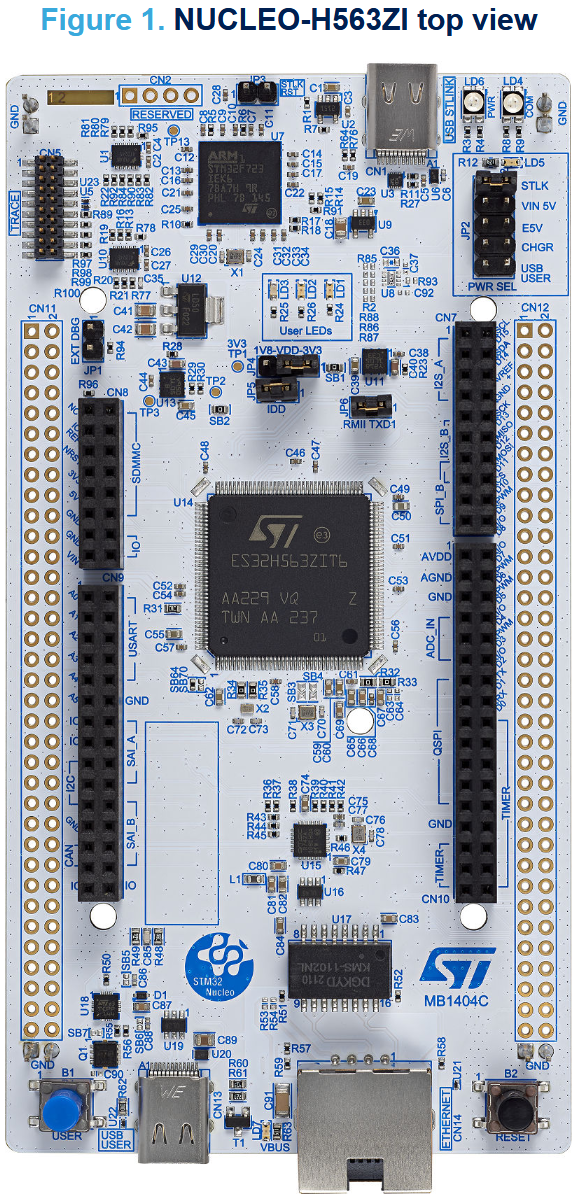ST Nucleo-H563ZI

Board Information
This page discusses issues unique to NuttX configurations for the STMicro NUCLEO-H563ZI development board featuring the STM32H563ZI MCU. The STM32H563ZI is a 250MHz Cortex-M33 operation with 2MBytes Flash memory and 640KByte SRAM. The board features:
On-board ST-LINK-V3EC for programming and debugging
3 user LEDs
Two pushbuttons (user and reset)
32.768 kHz crystal oscillator
USB Type-C connectors
Ethernet connector compliant with IEEE-802.3-2002
Board connectors: - 2x USB-C - Ethernet RJ45 - ST Zio connector including Arduino Uno V3 - ST morpho
Refer to the http://www.st.com website for further information about this board (search keyword: NUCLEO-H563ZI)
Serial Console
Many options are available for a serial console via the Morpho connector. Here two common serial console options are suggested:
Nucleo Virtual Console.
The virtual console uses Serial Port 3 (USART3) with TX on PD8 and RX on PD9.
VCOM Signal
Pin
SERIAL_RX
PD9
SERIAL_TX
PD8
These signals are internally connected to the on board ST-Link.
The Nucleo virtual console is the default serial console in all configurations unless otherwise stated in the description of the configuration.
Arduino Serial Shield.
If you are using a standard Arduino RS-232 shield with the serial interface with RX on pin D0 and TX on pin D1 from LPUART1:
ARDUINO
FUNCTION
GPIO
DO RX
LPUART1_RX
PB7
D1 TX
LPUART1_TX
PB6
Configurations
Information Common to All Configurations
Each Nucleo-H563ZI configuration is maintained in a sub-directory and can be selected as follows:
tools/configure.sh [options] nucleo-h563zi:<subdir>
Where options should specify the host build platform (-l for Linux, -c for Cygwin under Windows, etc.). Try ‘tools/configure.sh -h’ for the complete list of options.
Before starting the build, make sure that (1) your PATH environment variable includes the correct path to your toolchain, and (2) you have the correct toolchain selected in the configuration.
And then build NuttX by simply typing the following. At the conclusion of the make, the nuttx binary will reside in an ELF file called, simply, nuttx.:
make
The <subdir> that is provided above as an argument to the tools/configure.sh must be is one of the following.
NOTES:
These configurations use the mconf-based configuration tool. To change any of these configurations using that tool, you should:
Build and install the kconfig-mconf tool. See nuttx/README.txt see additional README.txt files in the NuttX tools repository.
Execute ‘make menuconfig’ in nuttx/ in order to start the reconfiguration process.
Unless stated otherwise, all configurations generate console output on the ST-Link VCOM, USART3.
Unless otherwise stated, the configurations are setup for Linux by default:
Build Setup:
CONFIG_HOST_LINUX=y : Linux host operating system
All of these configurations use the general arm-none-eabi toolchain for Linux That toolchain selection can easily be reconfigured using ‘make menuconfig’.
These configurations all assume that you are loading code using something like the ST-Link v3 JTAG. None of these configurations are setup to use the DFU bootloader but should be easily reconfigured to use that bootloader if so desired.
Configuration Sub-directories
nsh:
This configuration provides a basic NuttShell configuration (NSH) for the Nucleo-H563ZI. The default console is the VCOM on USART3.
adc:
This configuration configures ADC1_IN3 and ADC1_IN10, which can be accessed at the CN9 A0 and A1 pins respectively. Modify nucleo-h563zi/src/stm32_adc.c to enable more channels.
pwm:
This configuration configures TIM1_CH1OUT, which can be accessed at pin D6 on the CN10 A0 connector. TIM1_CH1 is configured as a pwm output at /dev/pwm0, and can be tested with the example pwm application.
adc_watchdog:
Test Procedure:
Build and flash NuttX with the above Kconfig. Register /dev/adc0 via the board init.
Start continuous conversions (DMA circular enabled) and run the adc example to sanity-check normal operation.
Tie both CH3 and CH10 to GND → verified no AWD interrupts and ADC continues normally.
Tie either CH3 or CH10 to 3.3 V with AWD1 set to “all channels” → ISR fires as expected; conversions continue; AWD1 IRQ is disabled by the ISR.
Switch to single-channel AWD1.
Select CH3: drive CH3 above the window → ISR fires; drive CH10 above the window → no ISR.
Select CH10: mirror the above.
Re-enable the watchdog interrupt using the driver IOCTL; confirm subsequent out-of-window events retrigger the ISR.
usbnsh:
This configuration provides a basic NuttShell through the USB User interface.
dts:
This configuration configures the digital temperature sensor (DTS) at /dev/uorb/sensor_temp0 and provides the test application sensortest. E.g. sensortest -n 10 temp0
References
[UM3115] - STM32H5 Nucleo-144 board (MB1404)